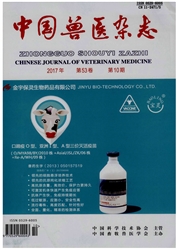

 中文摘要:
中文摘要:
应用RT—PCR方法对华南地区某大型猪场疑似猪流行性腹泻病料检测,选取阳性病料接种到Veto细胞,命名为CH/GDGZ/2012(简称GD-12)株。用病毒RNA抽提物为模板,对GD-12的S基因抗原区片段的扩增、克隆后进行核苷酸测序。序列分析表明,CH/GDGZ/2012与CV777、Chinju99、Br1/87、DR13和SM98的核苷酸序列同源性分别为96.9%、93.0%、95.7%、96.7%和96。0%,氨基酸序列的同源性分别为97.7%、91.5%、95.4%、98.0%和94.8%。进化树分析结果显示,华南地区CH/GD-01/2011、CH/GDGZ/2012、GDHSY/2011、CH/GXQZ/2011毒株与经典毒株的遗传距离较大,处于不同的亚群。研究表明,PEDVGD-12株已发生遗传变异、关键抗原表位发生较大变化,该研究可为诊断和防控该病提供参考。
 英文摘要:
英文摘要:
Porcine epidemic diarrhea virus(PEDV)specific RT-PCR was used to detect tissue samples of diseased pigs in south China. Tissue samples of diseased pigs were inoculated in Vero cells and cultured to the third generation. The major antigenic epitope of S gene of the PEDV isolate was amplified cloned and sequenced. Sequence analysis showed that the S gene of CH/GDGZ/2012 strain was 96.9%,93.0%, 95.7%,96.7% and 96.0% identical at nucleotide sequence level and 97.7%,91.5%495.4%,98.0% and 94.8% identical at amino acid sequence level compared to that of strains CV777,Chinju99,Brl/87,DR13 and SM98, respectively. CH/GDGZ/2012 and CH/GD-01/2011,GDHSY/2011,CH/GXQZ/2011 belonged to the same subgroup based on phylogenetic tree established with nucleotide sequences of the S genes of PEDV strains. The results indicate that the genetic variability of the virus and major epitopes changed greatly. The study can provide a reference for the diagnosis and prevention and control of the disease.
 同期刊论文项目
同期刊论文项目
 同项目期刊论文
同项目期刊论文
 swIFN-beta promotes genetic mutation of porcine reproductive and respiratory syndrome virus in Marc-
swIFN-beta promotes genetic mutation of porcine reproductive and respiratory syndrome virus in Marc- 期刊信息
期刊信息
